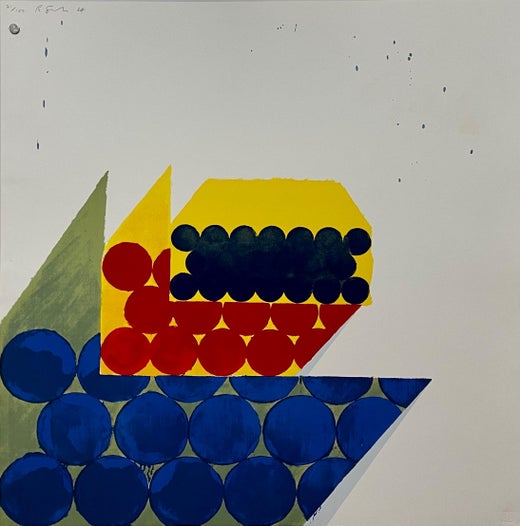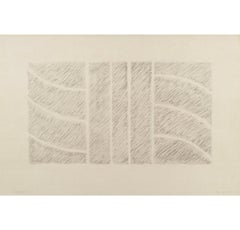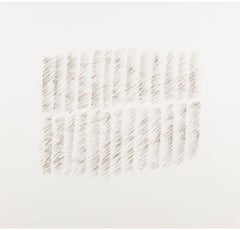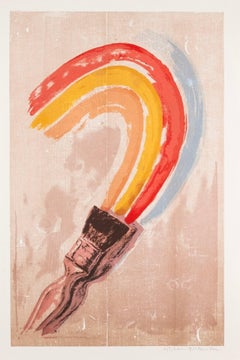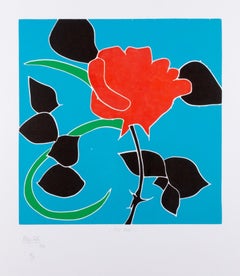Want more images or videos?
Request additional images or videos from the seller
1 of 6
Richard SmithHorizon V (Peach, Yellow & Green), Abstract Lithograph Print, 19701970
1970
$2,636.85List Price
About the Item
- Creator:Richard Smith (1931 - 2016, English)
- Creation Year:1970
- Dimensions:Height: 13 in (33.02 cm)Width: 28 in (71.12 cm)
- Medium:
- Period:
- Condition:
- Gallery Location:Kingsclere, GB
- Reference Number:1stDibs: LU2718214580692
Richard Smith
Charles Richard "Dick" Smith was an English printmaker and painter. He Attended St Albans School of Art followed by post-graduate studies at the Royal College of Art, London, from 1954-57. Smith shared a flat-cum-studio with Peter Blake in his second year at the RCA, and then again for two years after he left the college in 1957. When Terence Conran's Soup Kitchen opened on Fleet Street in the late 1950s, it featured a letter-collage mural by Smith and Blake. Michael Chow would later commission Smith to design installations for his restaurant in Los Angeles, and Chow and Conran have remained two of his biggest supporters. In 1959 he moved to New York to teach on a Harkness Fellowship, staying for two years, where he produced paintings combining the formal qualities of many of the American abstract painters which made references to American commercial culture. The artist's first solo exhibition was at the Green Gallery. As his work matured it tended to be more minimal, often painted using one colour with a second only as an accent. In trying to find ways of transposing ideas, Smith began to question the two-dimensional properties of art itself and to find ways by which a painting could express the shape of reality as he saw it. These principles he carried into his graphic work by introducing cut, folded and stapled elements into his prints; some works were multi-leaved screenprinting, and others printed onto three-dimensional fabricated metal. Smith returned to England in 1963 - specifically East Tytherton, Wiltshire where Howard Hodgkin was a neighbour - and gained critical acclaim for extending the boundaries of painting into three dimensions, creating sculptural shaped canvases with monumental presence, which literally protruded into the space of the gallery. Evocative titles such as Panatella and Revlon, and cosmetic, synthetic colours alluded to the consumer landscapes of urban America which had proved so influential. He showed at the Kasmin Gallery, a venture between Kas and the Marquess of Dufferin and Ava in New Bond Street, throughout the 60s, more-widely known as David Hockney's first gallery. Smith was invited to exhibit at the XXXV Venice Biennale as the official British artist in 1970. Smith taught with Richard Hamilton at Gateshead in 1965, where he met Mark Lancaster and Stephen Buckley, and again in 2000, becoming close to the artist and his wife, Terry. By the late 1960s Smith's ambition to produce paintings which shared a common sensibility with other media, such as film and photography, began to wane and he focused on the formal qualities of painting. First exhibited in New York in 1971, the traditional wooden supports of the canvases were replaced by aluminium rods and strings, allowing them to be hung freely in response to the surrounding architecture. Smith continued in the subsequent decades to construct site-specific works in public and private spaces often hanging from the ceilings or architectural supports. He resettled in Patchogue, New York in around 1977. Smith was awarded the CBE in 1971.
About the Seller
No Reviews Yet
Vetted Professional Seller
Every seller passes strict standards for authenticity and reliability
Established in 2010
1stDibs seller since 2024
43 sales on 1stDibs
Typical response time: 9 hours
Authenticity Guarantee
In the unlikely event there’s an issue with an item’s authenticity, contact us within 1 year for a full refund. DetailsMoney-Back Guarantee
If your item is not as described, is damaged in transit, or does not arrive, contact us within 7 days for a full refund. Details24-Hour Cancellation
You have a 24-hour grace period in which to reconsider your purchase, with no questions asked.Vetted Professional Sellers
Our world-class sellers must adhere to strict standards for service and quality, maintaining the integrity of our listings.Price-Match Guarantee
If you find that a seller listed the same item for a lower price elsewhere, we’ll match it.Trusted Global Delivery
Our best-in-class carrier network provides specialized shipping options worldwide, including custom delivery.You May Also Like
Mid-Century Modernist Lithograph Poster "Politiken" signed Ib Anderson
Located in New York, NY
This striking Mid-Century Modernist lithograph poster, designed for the Danish newspaper Politiken, is a masterful example of Scandinavian graphic design from the 1960s. Signed by th...
Category
1960s Abstract Prints
Materials
Lithograph
$3,475
H 27 in W 70 in D 1.5 in
Domaine de la Baume
By Bernard Buffet
Located in Paris, FR
Lithograph, 1986
Edition : EA XXVI/XXX
Printer : Sorlier (Paris)
Catalog : [Sorlier II, jacquette de couverture]
54.00 cm. x 76.00 cm. 21.26 in. x 29.92 in. (paper)
35.00 cm. x 54.0...
Category
1980s Abstract Abstract Prints
Materials
Lithograph
Le Bouquet
By Georges Braque
Located in Paris, FR
Lithograph, 1962
Edition : HC 10/125
Publisher : André Sauret (Monte-Carlo)
Printer : Mourlot (Paris)
Catalog : [Vallier 188, p. 284]
33.00 cm. x 52.00 cm. 12.99 in. x 20.47 in. (p...
Category
1960s Abstract Abstract Prints
Materials
Lithograph
Peace Array, Abstract Lithograph by Dimitri Petrov
By Dimitri Petrov
Located in Long Island City, NY
Dimitri Petrov, American (1919 - 1986) - Peace Array, Year: circa 1975, Medium: Lithograph, signed and numbered in pencil, Edition: 200, Size: 22 x 29.5 in. (55.88 x 74.93 cm)
Category
1970s Abstract Expressionist Abstract Prints
Materials
Lithograph
Abstract in Primary Colors, Signed Lithograph by Dimitri Petrov
By Dimitri Petrov
Located in Long Island City, NY
Dimitri Petrov, American (1919 - 1986) - Untitled - Abstract in Primary Colors, Year: circa 1975, Medium: Lithograph, signed and numbered in pencil, Edition: AP 48, Size: 22 x 3...
Category
1970s Abstract Expressionist Abstract Prints
Materials
Lithograph
Green Abstract, Signed Lithograph by Dimitri Petrov
By Dimitri Petrov
Located in Long Island City, NY
Dimitri Petrov, American (1919 - 1986) - Untitled - Green Abstract, Year: circa 1975, Medium: Lithograph, signed and numbered in pencil, Edition: 175, Size: 22 x 30 in. (55.88 ...
Category
1970s Abstract Expressionist Abstract Prints
Materials
Lithograph
Futuristic Cityscape II, Abstract Lithograph by Dimitri Petrov
By Dimitri Petrov
Located in Long Island City, NY
Dimitri Petrov, American (1919 - 1986) - Untitled - Futuristic Cityscape II, Year: circa 1975, Medium: Lithograph, signed and numbered in pencil, Edition: AP 31, Size: 22 x 30 i...
Category
1970s Abstract Expressionist Abstract Prints
Materials
Lithograph
Futuristic Cityscape I, Abstract Lithograph by Dimitri Petrov
By Dimitri Petrov
Located in Long Island City, NY
Dimitri Petrov, American (1919 - 1986) - Untitled - Futuristic Cityscape I, Year: circa 1975, Medium: Lithograph, signed and numbered in pencil, Edition: 250, Size: 21.5 x 30 in...
Category
1970s Abstract Expressionist Abstract Prints
Materials
Lithograph
Abstract Handstand, Signed Lithograph by Dimitri Petrov
By Dimitri Petrov
Located in Long Island City, NY
Dimitri Petrov, American (1919 - 1986) - Abstract Handstand, Year: circa 1975, Medium: Lithograph, signed and numbered in pencil, Edition: 200, Size: 30 x 22 in. (76.2 x 55.88 cm)
Category
1970s Abstract Expressionist Abstract Prints
Materials
Lithograph
Horse Study, Abstract Lithograph by Dimitri Petrov
By Dimitri Petrov
Located in Long Island City, NY
Dimitri Petrov, American (1919 - 1986) - Horse Study, Year: circa 1975, Medium: Lithograph, signed and numbered in pencil, Edition: 250, Size: 22 x 30 in. (55.88 x 76.2 cm)
Category
1970s Abstract Expressionist Abstract Prints
Materials
Lithograph
More From This Seller
View AllRelief by Kim Lim, 1993
By Kim Lim
Located in Kingsclere, GB
Relief by Kim Lim, 1993
Additional information:
Medium: lithograph
51.3 x 76 cm
20 1/4 x 29 7/8 in
signed, dated and numbered in pencil
Kim Lim was born in Singapore and spent much of her early childhood in Penang and Malacca. After her schooling in Singapore, Lim knew that she wanted to become an artist, and at eighteen, she enrolled at St. Martin's in London, where she spent two years concentrating mainly on wood carving. She then transferred to the Slade, where taught by the etcher Anthony Gross and lithographer Stanley Jones, she developed a strong commitment to print making.
On journeys back to Singapore she stopped off in Europe and India, soaking up the art 'like a sponge'. These were the experiences that confirmed in her a lifelong predilection for things archaic, and for the flow and rhythm of Indian and South East Asian sculpture: " I found that I always responded to things that were done in earlier civilizations that seemed to have less elaboration and more strength." In Greece she was entranced by Cycladic sculpture. Of Chinese art she was moved most by early Shang bronzes, Han sculpture, Sung pottery...
Category
20th Century Abstract Prints
Materials
Lithograph
Shaded Grey by Kim Lim, 1993 - Minimalist Textural Print, White and Grey
By Kim Lim
Located in Kingsclere, GB
Shaded Grey by Kim Lim, 1993
Additional information:
Medium: lithograph
52.5 x 56 cm
20 5/8 x 22 1/8 in
signed, dated and numbered 20/20 in pencil
Kim Lim was born in Singapore and spent much of her early childhood in Penang and Malacca. After her schooling in Singapore, Lim knew that she wanted to become an artist, and at eighteen, she enrolled at St. Martin's in London, where she spent two years concentrating mainly on wood carving. She then transferred to the Slade, where taught by the etcher Anthony Gross and lithographer Stanley Jones, she developed a strong commitment to print making.
On journeys back to Singapore she stopped off in Europe and India, soaking up the art 'like a sponge'. These were the experiences that confirmed in her a lifelong predilection for things archaic, and for the flow and rhythm of Indian and South East Asian sculpture: " I found that I always responded to things that were done in earlier civilizations that seemed to have less elaboration and more strength." In Greece she was entranced by Cycladic sculpture. Of Chinese art she was moved most by early Shang bronzes, Han sculpture, Sung pottery...
Category
20th Century Abstract Prints
Materials
Lithograph
Untitled (Paintbrush) by Michael Rothenstein, 1974 circa
Located in Kingsclere, GB
Untitled (Paintbrush) by Michael Rothenstein, 1974 circa
Additional information:
Medium: lithograph
40.6 x 61 cm
16 x 24 in
signed in pencil
Michael Rothenstein was born in 1908 in...
Category
20th Century Abstract Prints
Materials
Lithograph
Fiji Rose, Graphic Blue and Red Colour Print with Flower, 1973
By Philip Sutton
Located in Kingsclere, GB
Fiji Rose by Philip Sutton, 1973
Additional information:
Medium:lithograph
87 x 68 cm
34 1/4 x 26 3/4 in
signed, dated, titled and inscribed AP in pencil
Philip Sutton is a British...
Category
20th Century Still-life Prints
Materials
Lithograph
Variations on Six (Blue on Black) by Clifford Ellis, 1953
By Clifford Ellis
Located in Kingsclere, GB
Variations on Six (Blue on Black) by Clifford Ellis, 1953
Additional information:
Medium: lithograph
85 x 64.5 cm
33 1/2 x 25 3/8 in
Clifford Ellis was born in Bognor Regis, West S...
Category
20th Century Abstract Prints
Materials
Lithograph
Rav 4 by Brian Fielding, 1982 circa
By Brian Fielding
Located in Kingsclere, GB
Rav 4 by Brian Fielding, 1982 circa
Additional information:
Medium: lithograph
76.5 x 58 cm
30 1/8 x 22 7/8 in
signed, titled and inscribed AP in penci...
Category
20th Century Abstract Prints
Materials
Lithograph
Recently Viewed
View AllMore Ways To Browse
Jewish Pop Art
Joan Miro Barcelona Lithograph
Joan Miro Large
Joan Miro Limited Edition
Joan Mitchell Lithograph
Kenneth Noland Lithograph
Manoela Madera
Matisse Pochoir
Matsutani Takesada
Miro Sobreteixims
Mr Doodle
Noemi Gerstein
Peter Max Flower Abstract
Pia Stern
Print Signed Whitney
Putman Art
Rauschenberg Stoned Moon
Rene Lubarow
